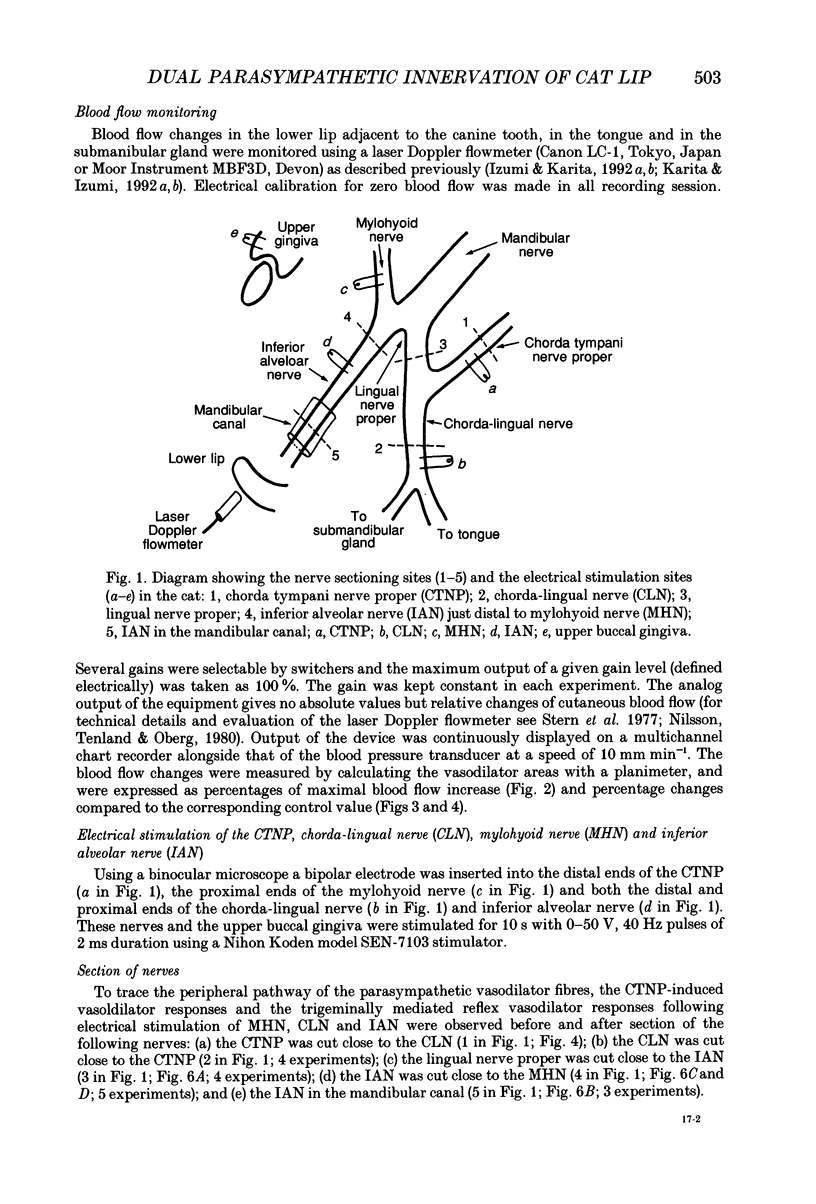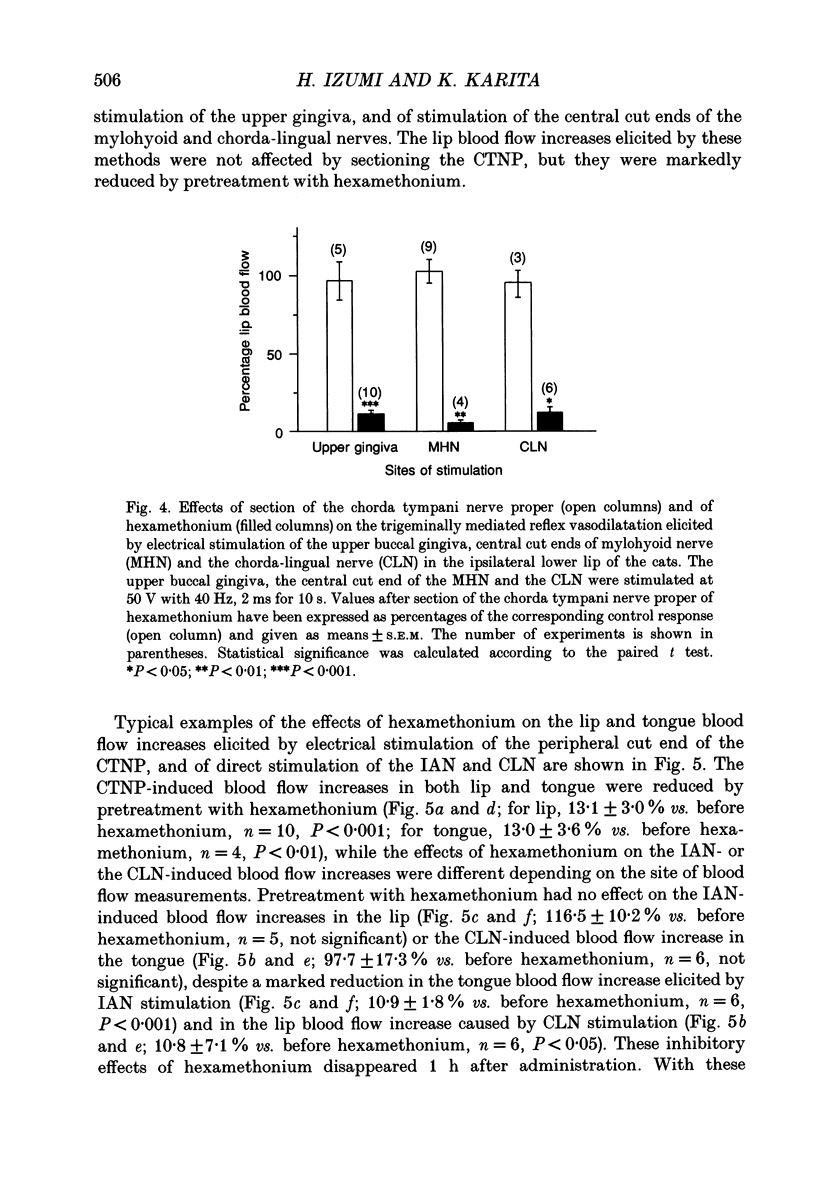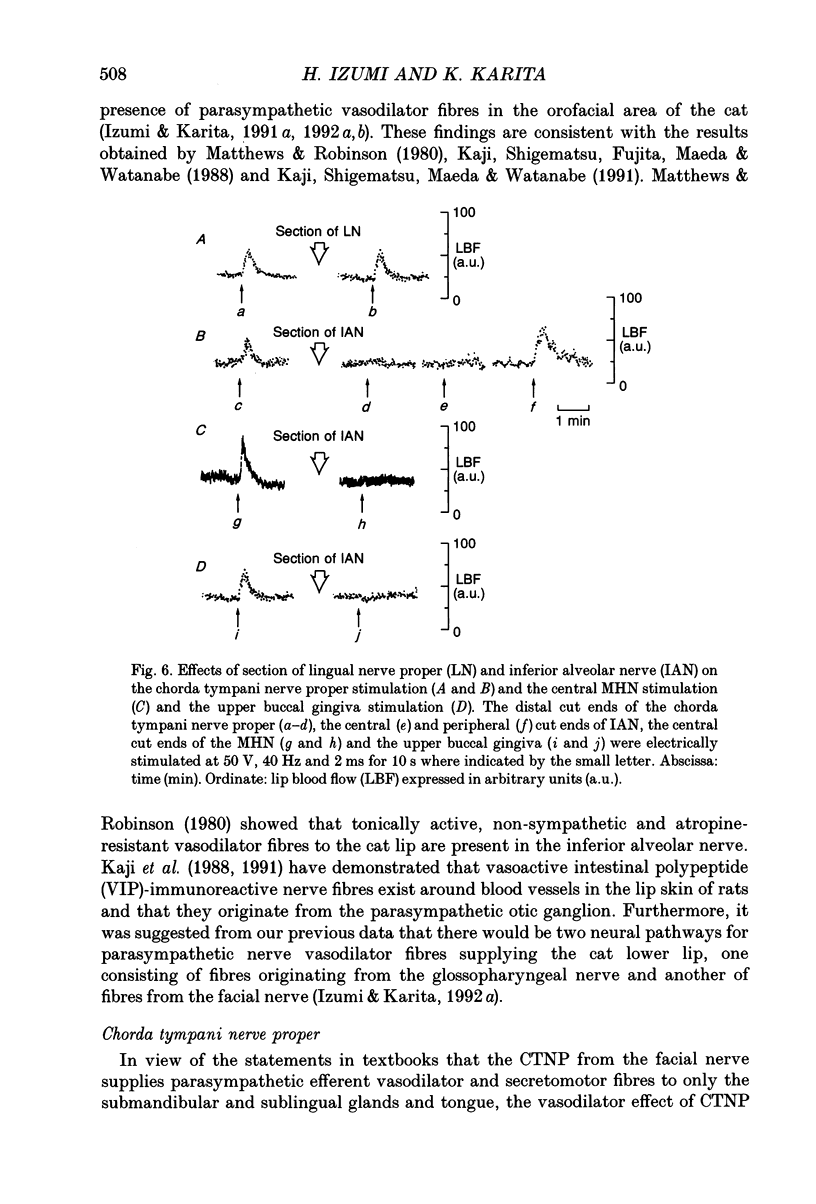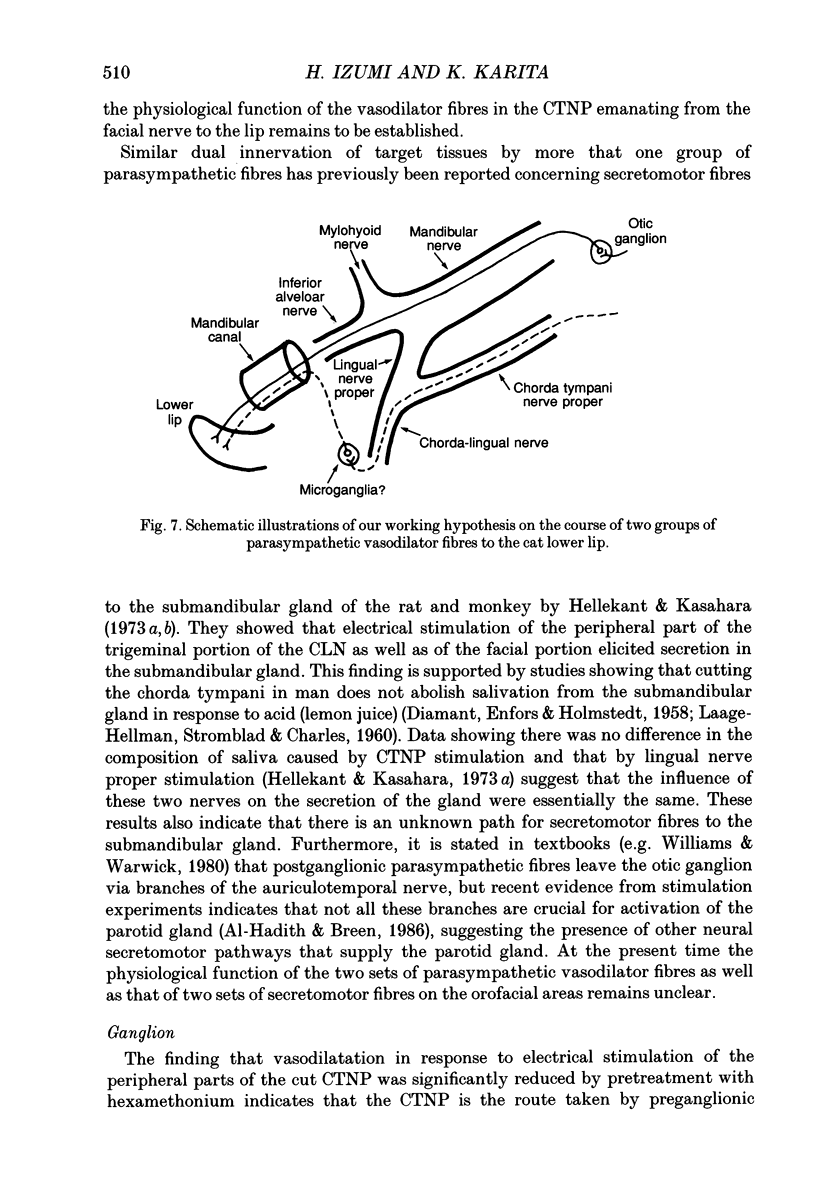Abstract
1. Electrical stimulation of the peripheral cut ends of the chorda tympani nerve proper (CTNP) and the chorda-lingual nerve (CLN) elicited a blood flow increase in the ipsilateral lower lip, tongue and submandibular gland in a stimulus intensity-dependent manner in anaesthetized cats. 2. Pretreatment with hexamethonium (1.0 mg kg-1, i.v.), an autonomic ganglionic blocker, significantly reduced the CTNP-induced blood flow increases in all of the above three sites as well as the CLN-induced blood flow in the lower lip, but it had no effects on the CLN-induced blood flow increases in the tongue and submandibular gland. 3. The CTNP stimulation-induced lower lip blood flow was not influenced by sectioning the lingual nerve proper, but it was abolished by section of either the CLN or the inferior alveolar nerve (IAN) in the mandibular canal. 4. The lip blood flow increases elicited reflexly by electrical stimulation of the upper gingiva, the central cut ends of the mylohyoid nerve and CLN were not affected by cutting of the CTNP, but were markedly reduced by pretreatment with hexamethonium and abolished by the section of the inferior alveolar nerve just distal to the mylohyoid nerve. These observations imply that the parasympathetic vasodilator fibres involved in trigeminally induced reflex vasodilatation responses do not travel with the CTNP. 5. These results suggest that there is a dual innervation of the cat lower lip by two groups of parasympathetic vasodilator fibres; in one case fibres originating from the facial nerve root are distributed to the lower lip via the CTNP, CLN and IAN and in the other fibres emanating from the glossopharyngeal nerve root project to the lower lip via the mandibular nerve and the IAN.
Full text
PDF











Selected References
These references are in PubMed. This may not be the complete list of references from this article.
- DIAMANT H., ENFORS B., HOLMSTEDT B. Salivary secretion in man elicited by means of stimulation of the chorda tympani. Acta Physiol Scand. 1959 Apr 22;45(4):293–299. doi: 10.1111/j.1748-1716.1959.tb01701.x. [DOI] [PubMed] [Google Scholar]
- Farbman A. I., Hellekant G. Quantitative analyses of the fiber population in rat chorda tympani nerves and fungiform papillae. Am J Anat. 1978 Dec;153(4):509–521. doi: 10.1002/aja.1001530403. [DOI] [PubMed] [Google Scholar]
- Fitzgerald M. J., Alexander R. W. The intramscular ganglia of the cat's tongue. J Anat. 1969 Jul;105(Pt 1):27–46. [PMC free article] [PubMed] [Google Scholar]
- Gautvik K. The interaction of two different vasodilator mechanisms in the chorda-tympani activated submandibular salivary gland. Acta Physiol Scand. 1970 Jun;79(2):188–203. doi: 10.1111/j.1748-1716.1970.tb04719.x. [DOI] [PubMed] [Google Scholar]
- Gibbins I. L., Brayden J. E., Bevan J. A. Perivascular nerves with immunoreactivity to vasoactive intestinal polypeptide in cephalic arteries of the cat: distribution, possible origins and functional implications. Neuroscience. 1984 Dec;13(4):1327–1346. doi: 10.1016/0306-4522(84)90301-4. [DOI] [PubMed] [Google Scholar]
- Gibbins I. L. Target-related patterns of co-existence of neuropeptide Y, vasoactive intestinal peptide, enkephalin and substance P in cranial parasympathetic neurons innervating the facial skin and exocrine glands of guinea-pigs. Neuroscience. 1990;38(2):541–560. doi: 10.1016/0306-4522(90)90049-a. [DOI] [PubMed] [Google Scholar]
- Hellekant G., Kasahara Y. Salivatory fibres in the trigeminal part of the lingual nerve to the mandibular salivary gland of the monkey. Acta Physiol Scand. 1973 Oct;89(2):208–212. doi: 10.1111/j.1748-1716.1973.tb05513.x. [DOI] [PubMed] [Google Scholar]
- Hellekant G., Kasahara Y. Secretory fibres in the trigeminal part of the lingual nerve to the mandibular salivary gland of the rat. Acta Physiol Scand. 1973 Oct;89(2):198–207. doi: 10.1111/j.1748-1716.1973.tb05512.x. [DOI] [PubMed] [Google Scholar]
- Hellekant G. On the relation between the chorda tympani nerve response, arterial oxygen tension and blood flow in the tongue of the rat. Acta Physiol Scand. 1971 Aug;82(4):453–459. doi: 10.1111/j.1748-1716.1971.tb04989.x. [DOI] [PubMed] [Google Scholar]
- Hellekant G. The effect of changes in the blood flow to the tongue on the chorda tympani response in rat. Acta Physiol Scand. 1971 Jun;82(2):145–153. doi: 10.1111/j.1748-1716.1971.tb04953.x. [DOI] [PubMed] [Google Scholar]
- Hellekant G. Vasodilator fibres to the tongue in the chorda tympani proper nerve. Acta Physiol Scand. 1977 Mar;99(3):292–299. doi: 10.1111/j.1748-1716.1977.tb10382.x. [DOI] [PubMed] [Google Scholar]
- Hiura A., Ishizuka H., Sakamoto Y. Electron microscopic study of the effect of capsaicin on the mouse chorda tympani nerves. Arch Oral Biol. 1990;35(11):913–916. doi: 10.1016/0003-9969(90)90072-i. [DOI] [PubMed] [Google Scholar]
- Izumi H., Karita K. Axon reflex vasodilatation in human skin measured by a laser Doppler technique. Jpn J Physiol. 1991;41(5):693–702. doi: 10.2170/jjphysiol.41.693. [DOI] [PubMed] [Google Scholar]
- Izumi H., Karita K. Investigation of mechanisms of the flare and wheal reactions in human skin by band method. Brain Res. 1988 May 24;449(1-2):328–331. doi: 10.1016/0006-8993(88)91047-5. [DOI] [PubMed] [Google Scholar]
- Izumi H., Karita K. Somatosensory stimulation causes autonomic vasodilatation in cat lip. J Physiol. 1992 May;450:191–202. doi: 10.1113/jphysiol.1992.sp019123. [DOI] [PMC free article] [PubMed] [Google Scholar]
- Izumi H., Karita K. The effects of capsaicin applied topically to inferior alveolar nerve on antidromic vasodilatation in cat gingiva. Neurosci Lett. 1990 Apr 20;112(1):65–69. doi: 10.1016/0304-3940(90)90323-2. [DOI] [PubMed] [Google Scholar]
- Izumi H., Karita K. Vasodilator responses following intracranial stimulation of the trigeminal, facial and glossopharyngeal nerves in the cat gingiva. Brain Res. 1991 Sep 27;560(1-2):71–75. doi: 10.1016/0006-8993(91)91216-n. [DOI] [PubMed] [Google Scholar]
- Izumi H., Kuriwada S., Karita K., Sasano T., Sanjo D. The nervous control of gingival blood flow in cats. Microvasc Res. 1990 Jan;39(1):94–104. doi: 10.1016/0026-2862(90)90061-u. [DOI] [PubMed] [Google Scholar]
- Kaji A., Maeda T., Watanabe S. Parasympathetic innervation of cutaneous blood vessels examined by retrograde tracing in the rat lower lip. J Auton Nerv Syst. 1991 Feb;32(2):153–158. doi: 10.1016/0165-1838(91)90065-b. [DOI] [PubMed] [Google Scholar]
- Kaji A., Shigematsu H., Fujita K., Maeda T., Watanabe S. Parasympathetic innervation of cutaneous blood vessels by vasoactive intestinal polypeptide-immunoreactive and acetylcholinesterase-positive nerves: histochemical and experimental study on rat lower lip. Neuroscience. 1988 Apr;25(1):353–362. doi: 10.1016/0306-4522(88)90031-0. [DOI] [PubMed] [Google Scholar]
- Karita K., Izumi H. Somatosensory afferents in the parasympathetic vasodilator reflex in cat lip. J Auton Nerv Syst. 1992 Jul;39(3):229–234. doi: 10.1016/0165-1838(92)90016-a. [DOI] [PubMed] [Google Scholar]
- Kuchiiwa S., Izumi H., Karita K., Nakagawa S. Origins of parasympathetic postganglionic vasodilator fibers supplying the lips and gingivae; an WGA-HRP study in the cat. Neurosci Lett. 1992 Aug 17;142(2):237–240. doi: 10.1016/0304-3940(92)90381-g. [DOI] [PubMed] [Google Scholar]
- LAAGE-HELLMAN J. E., STROMBLAD B. C. Secretion from human submaxillary gland after section of the chorda tympani. J Appl Physiol. 1960 Mar;15:295–297. doi: 10.1152/jappl.1960.15.2.295. [DOI] [PubMed] [Google Scholar]
- Matthews B., Robinson P. P. The course of post-ganglionic sympathetic fibres distributed with the trigeminal nerve in the cat. J Physiol. 1980 Jun;303:391–401. doi: 10.1113/jphysiol.1980.sp013294. [DOI] [PMC free article] [PubMed] [Google Scholar]
- Nilsson G. E., Tenland T., Oberg P. A. Evaluation of a laser Doppler flowmeter for measurement of tissue blood flow. IEEE Trans Biomed Eng. 1980 Oct;27(10):597–604. doi: 10.1109/TBME.1980.326582. [DOI] [PubMed] [Google Scholar]
- Robinson P. P. The characteristics and regional distribution of afferent fibres in the chorda tympani of the cat. J Physiol. 1988 Dec;406:345–357. doi: 10.1113/jphysiol.1988.sp017384. [DOI] [PMC free article] [PubMed] [Google Scholar]
- Stern M. D., Lappe D. L., Bowen P. D., Chimosky J. E., Holloway G. A., Jr, Keiser H. R., Bowman R. L. Continuous measurement of tissue blood flow by laser-Doppler spectroscopy. Am J Physiol. 1977 Apr;232(4):H441–H448. doi: 10.1152/ajpheart.1977.232.4.H441. [DOI] [PubMed] [Google Scholar]


